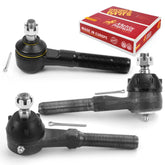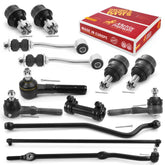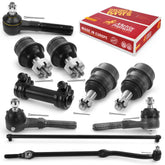Everything You Need to Know About Car Bushings

Car bushings are essential components of a car's suspension system, providing a cushioning effect between the various metal parts and dampening vibrations while the car is in motion. In this blog, we will discuss everything you need to know about car bushings, including what they are, what they are made of, where they are used, how long they last, signs that they need replacing, and what happens when they wear out.
What are car bushings?
Bushings are small, flexible, cylindrical components that are designed to provide a cushioning effect between the various metal parts in a car's suspension system. They are usually made from rubber, polyurethane, or a combination of both, and they help to dampen vibrations and reduce noise while the car is in motion. Bushings come in many different shapes and sizes, depending on the specific application, and they are often used in areas where metal parts meet each other, such as the suspension system.
What are car bushings made of?
Car bushings can be made from various materials, including rubber, polyurethane, and a combination of both. Rubber bushings are the most common and are generally the least expensive. They are ideal for absorbing vibrations and dampening noise but tend to wear out more quickly than other types of bushings.
Polyurethane bushings are more durable than rubber bushings and tend to last longer. They are stiffer than rubber bushings and provide better handling, making them ideal for performance applications. They are also more resistant to chemicals and can withstand higher temperatures.
How long do bushings on a car last?
The lifespan of car bushings will depend on several factors, including the type of bushing, the materials used, and the conditions in which the car is driven. Generally, rubber bushings tend to wear out more quickly than polyurethane bushings and may need to be replaced every 50,000 miles or so. Polyurethane bushings can last much longer, often up to 100,000 miles or more.
Signs that your car bushes need replacing
There are several signs that your car's bushings may need to be replaced, including:
- Excessive noise: If you hear clunking or rattling noises while driving over bumps, this could be a sign that your bushings are worn out.
- Vibration: If you feel excessive vibration while driving, this could be a sign that your bushings are no longer able to dampen the vibrations properly.
- Uneven tire wear: If your tires are wearing out unevenly, this could be a sign that your bushings are no longer providing the proper support and alignment.
- Handling issues: If your car is experiencing handling issues, such as drifting or pulling to one side, this could be a sign that your bushings are worn out and need to be replaced.
Where are bushings used in a car's parts?
Bushings are used in several places throughout a car's suspension system to provide cushioning and support, reduce noise and vibration, and help maintain proper alignment. Here are some of the most common types of bushings and where they are used in a car's suspension:
- Control arm bushings: Control arm bushings are used in the front suspension of most cars to attach the control arms to the frame of the car. They allow the control arms to move up and down with the wheels while keeping them securely attached to the frame. Control arm bushings are typically made of rubber or polyurethane. Rubber bushings are more common and tend to be softer, which makes for a more comfortable ride but can also cause more suspension movement and less precise handling. Polyurethane bushings, on the other hand, are firmer and provide more stability and precise handling, but can also lead to a harsher ride. Some bushings may also be made of other materials, such as metal or plastic, depending on the specific application and the desired characteristics.
- Sway bar bushings: Sway bar bushings are used to connect the sway bar to the suspension system. The sway bar helps keep the car stable during turns by transferring weight from one side to the other. Sway bar bushings are typically made of rubber or polyurethane.
- Shock absorber bushings: Shock absorber bushings are used to attach the shock absorbers to the frame of the car. They help absorb the impact of bumps and other road irregularities and reduce noise and vibration. Shock absorber bushings, also known as shock mount bushings, are typically made of rubber, polyurethane, or a combination of both. Some shock absorber bushings are designed to be used with metal sleeves to provide added durability and support. The specific material used for shock absorber bushings may vary depending on the manufacturer and the specific application.
- Strut mount bushings: Strut mount bushings are used in cars with a MacPherson strut suspension system. They connect the strut to the body of the car and help absorb shocks and vibrations. Strut mount bushings are typically made of rubber or polyurethane.
- Leaf spring bushings: Leaf spring bushings are used in the rear suspension of many trucks and SUVs. They help support the weight of the vehicle and provide cushioning and support during bumps and other road irregularities. Leaf spring bushings are typically made of a hard rubber or polyurethane material, which can provide a durable and long-lasting solution for heavy-duty applications. The material used for leaf spring bushings needs to be able to withstand a lot of weight, stress, and impact without breaking down or deteriorating. Polyurethane bushings are becoming more popular due to their ability to provide better handling and reduce suspension movement, which can improve overall ride quality. Some leaf spring bushings are also designed to be used with metal sleeves or other reinforcement materials to provide added durability and support. The specific material used for leaf spring bushings may vary depending on the manufacturer and the specific application.
- Subframe bushings: Subframe bushings are used to connect the subframe to the body of the car. They help absorb the impact of bumps and other road irregularities and reduce noise and vibration. Subframe bushings are typically made of rubber or polyurethane.
In summary, bushings are used in several places throughout a car's suspension system to provide cushioning and support, reduce noise and vibration, and help maintain proper alignment. The type of bushing that is best for a particular application will depend on several factors, including the type of driving, the conditions in which the car is driven, and the car's performance needs.
Metrix Premium Chassis Parts offers bushes for all makes and models. Product offerings also include stabilizer bar links, control arm and ball joint assemblies and other steering and suspension components which all are made of high-quality bushes.









